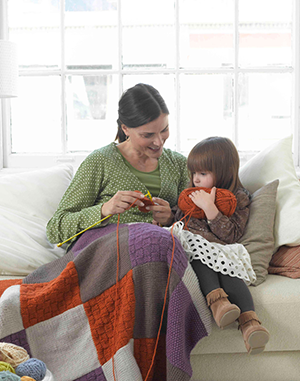 I learned to knit when I was eight. It was summer, school was out. For entertainment I explored a rarely opened closet. There was a shopping bag stuffed with maroon yarn, and a cylindrical leatherette case which, unzipped, revealed a jumble of colored metal knitting needles. I dragged everything into the light.
I learned to knit when I was eight. It was summer, school was out. For entertainment I explored a rarely opened closet. There was a shopping bag stuffed with maroon yarn, and a cylindrical leatherette case which, unzipped, revealed a jumble of colored metal knitting needles. I dragged everything into the light.
“What is this?” I asked my mother.
“Oh,” she said. “It’s my knitting. A sweater….I think.”
How amazing. I’d never seen her knit—did she knit while I slept?—and, naively, couldn’t imagine why she’d abandon the project. It seemed sad that the yarn had languished in obscurity.
“Why don’t you finish it?”
I’ve forgotten her answer. Probably her “I’m too busy” mantra, accompanied by a giant exhale of cigarette smoke. I do remember thinking this yarn deserved a kinder fate.
“Will you teach me to knit?” I asked.
So it began. I knitted blankets for my dolls, then scarves. Later, I learned to read patterns, saved babysitting money for yarn, knitted hats and sweaters. As a teenager, I commuted between school and home on the New York subway, carrying textbooks and knitting. Knitting gave me something to do in transit, and as I walked through dicey neighborhoods between the subway station and our apartment, the needles, tucked under my arm and pointing forward, protected me from aspiring muggers.
Decades later, I’m still knitting. Knitting has been good for my health, I suppose. It’s a way to use downtime productively, and that reduces stress I experience during travel or when I subject myself, every evening, to the universal misery reported on television news. But that’s definitely not why I knit, nor is it why most people knit, despite media bulletins about knitting’s immune-system-boosting effects.
A knitter begins a project with hope for the future (I will finish this sock!) and, during the knitting process, imbues her work with dedication and caring. Regardless of the project—a hat for charity, a baby sweater, a scarf—time and effort, lovingly motivated, flow to the destined recipient. Whether the motivation is defined as altruism, the parent-child bond, the deepest friendship or romance, a knitted gift tells someone I hope this garment will protect you, and you are worth my time. Truly, knitted things can never be separated from hope and love, those guardians of welfare.
To know that knitting confers health benefits is far less compelling than the lust for a hand-knitted cashmere scarf. You knit to make something beautiful, unique, and warm. You knit because you care. And because it’s in your nature. Gradually the impulses merge. Why did you learn to knit? I often ask. The commonest replies are 1) my (mother, grandmother, aunt) taught me when I was a kid, and 2) my college roommate (friend, neighbor) was always knitting, and I asked her to teach me.
So it was for me. My mother taught me to knit, and I became a knitter. She gave it up; I took it on. When she was dying, I sat on her hospital bed knitting while she slept. She roused herself at one point, and focusing on my hands, suddenly asked, “When did you learn to knit? Who taught you?”
“You did,” I said. “When I was a kid.” She sighed and closed her eyes. I kept knitting, and knitting, and knitting.
—
Selma Moss-Ward writes and knits in Rhode Island. You can find her work on our blog, as well as Lion Brand’s monthly newsletter, Pattern Journal, which you can subscribe to here.